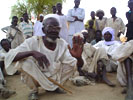
The fighting that heated up in Darfur last week continued through the weekend, with the United Nations now estimating that 150 to 400 civilians have died. Quoting an unnamed U.N. official, Reuters reported today that the civilian death toll from recent spate of fighting in Darfur could be as high as 400 and that the U.N. and aid organizations have been unable to access the area due to insecurity. Reports indicate that the market town of Deribat has been the epicenter of the attacks by the Sudanese army in recent days, forcing an estimated 40,000 people from their homes.
A week into the negotiations, the framework agreement signed between the Sudanese government and JEM still stands. However, in part due to the ongoing violence, peace talks in Doha between the Sudanese government and the largest rebel group, JEM, have “all but collapsed,” reported a source at the negotiations. JEM leader Khalil Ibrahim continues to refuse to proceed with negotiations as long as plans continue for the government to simultaneously negotiate with other rebel groups. The 10 rebel groups negotiating as the Liberation and Justice Movement are still working to finalize a framework agreement with the Government of Sudan in preparation to negotiate on a parallel track to the JEM-Sudanese government talks.
Notably, the SLA-Abdel Wahid rebel group, a faction linked to the influential Darfuri leader based in Paris, continues to refuse to join the talks, hampering the long-term viability of the negotiations. As we reported last week, there’s a sense that the Sudanese government may have ratcheted up attacks in the Darfuri rebel stronghold of Jebel Marra in an effort to compel the SLA-AW to join the talks in Doha.
But other assessments of the Government of Sudan’s strategy in Jebel Marra look even more sinister.
Among some rebel leaders, the question has arisen about whether the government planned to use the current talks to neutralize JEM, militarily the strongest, so that the Sudanese army could redirect its firepower toward the other rebel groups. The recent surge in violence is “part of a military strategy that the government insists on pursuing” in Darfur, said an Enough source. Regardless of the true calculations behind the current swell in government attacks, it’s not difficult to see how rebel groups might conclude that the Sudanese government hasn’t demonstrated a “good faith” effort to work toward peace.
Now’s the time for the U.S. government to take a hard look at its policy of not simply assessing efforts to promote peace in Sudan on “process-related accomplishments (i.e. the signing of a MOU or the issuance of a set of visas), but rather based on verifiable changes in conditions on the ground.” There is a clear disconnect between the progress touted in Doha and the deteriorating conditions on the ground in Darfur. How will the United States respond?
Photo: Elders in a camp for displaced people, Darfur

